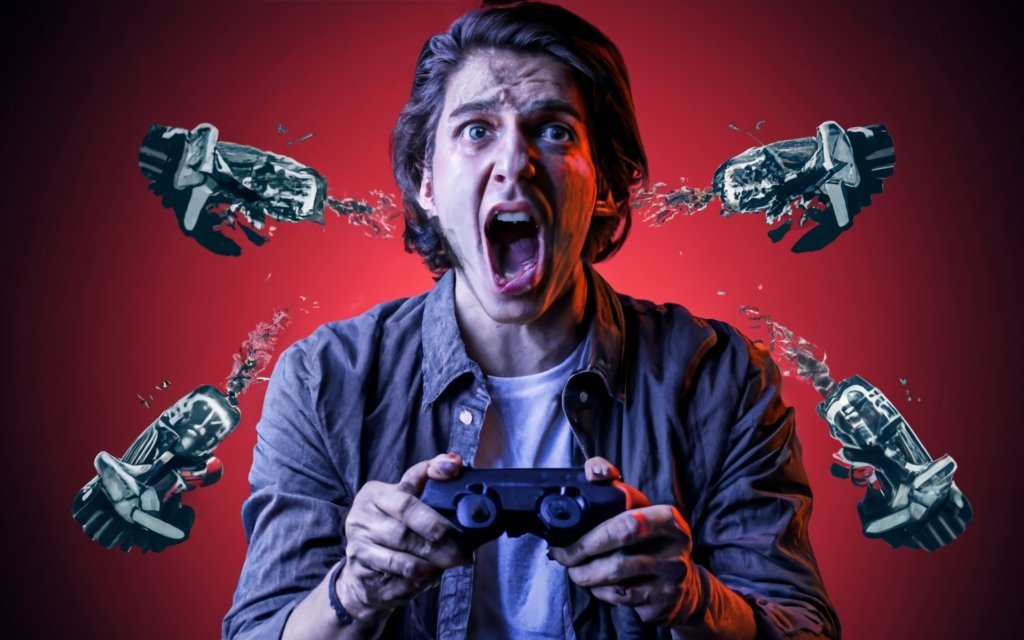Whether video games encourage violence is a complex and highly debated topic, with no definitive answer. There are arguments and evidence on both sides:
Arguments that video games can encourage violence:
- Increased aggression: Some studies have shown a link between playing violent video games and short-term increases in aggression, although the long-term effects are less clear. Players may experience desensitization to violence, making them more accepting or even supportive of it.
- Imitation of violence: Some people worry that games that depict violence in a realistic or rewarding way may encourage players to imitate those actions in real life, especially children who may struggle to distinguish between fantasy and reality.
- Emotional desensitization: Repeated exposure to graphic violence in games could potentially desensitize players to real-world violence, making them less likely to intervene or help victims.
Arguments that video games don’t encourage violence:
- Correlation vs. causation: Studies may show a correlation between playing violent games and increased aggression, but this doesn’t necessarily mean that one causes the other. There could be other factors at play, such as underlying personality traits or environmental influences.
- Positive effects of games: Video games can have many positive effects, such as improving hand-eye coordination, problem-solving skills, and social interaction. Some games can even teach prosocial values like cooperation and empathy.
- Individual differences: People respond differently to media, and what impacts one person may not affect another. Individual factors like personality, mental health, and family environment likely play a significant role in how someone reacts to violent content.
It’s important to remember that video games are just one of many factors that can influence behavior. While some people may be more susceptible to the potential negative effects of violent games, there is no single “gamer profile” that predicts violence.
Ultimately, responsible parental supervision and open communication are essential for ensuring that gaming is a safe and positive experience for children. There is this other article i wrote about >>>> Do Video Games Damage Your T.V? to learn more.
Level Up Your Understanding: Delving into Video Games and Violent Speech
Yo, fellow adventurers! Strap in, because we’re diving into a real-world quest: exploring the intricate connection between video games and, gulp, violent speech. This ain’t just a side quest, folks – it’s the final boss of heated debates and endless headlines.
But hey, fear not! As your trusty guide through this pixelated landscape, I’m here to shed some light, bust some myths, and level up your understanding with facts, firsthand experience, and a sprinkle of expert analysis.
First things first: Defining the Battlefield
Before we unleash our critical thinking skills, let’s grab some loot (aka definitions) to avoid friendly fire. What makes a game “violent”? Does it need exploding orc heads or a pixelated slap fight? Not necessarily!

Violence can lurk in the shadows of narrative choices, competitive banter, and even seemingly innocent emotes. Think of it like a spectrum, with cartoonish brawls on one end and emotionally charged in-game arguments on the other.
Now, “violent speech” – that’s a whole other dungeon. It’s not just hurling insults like digital confetti. It’s the dark magic of hate speech, threats, and harassment lurking in chat boxes and voice comms. We’re talking stuff so toxic it could make a troll blush.
Table Time: Shades of Violence in Games
| Game Genre | Potential Violence Types | Examples |
|---|---|---|
| Action/Adventure | Combat, gore, physical harm | Boss battles, weapon executions, character injuries |
| Strategy/Simulation | Psychological warfare, verbal aggression, resource manipulation | Propaganda campaigns, unit taunts, economic sabotage |
| Puzzle/Platformer | Environmental hazards, self-harm mechanics, competitive sabotage | Exploding platforms, timed challenges, player-versus-player traps |
| Role-Playing Games | Moral dilemmas, player-driven violence, narrative consequences | Siding with villains, harming NPCs, emotionally charged confrontations |
Bullet Points of Fury: When Words Become Weapons
- Competitive Heat: In the heat of the moment, trash talk and taunts can fly like flaming arrows in online arenas. But hey, remember, sportsmanship applies in virtual worlds too!
- The Groupthink Dungeon: Sometimes, online communities can breed echo chambers where aggressive language becomes normalized. Think twice before joining the chorus of hate.
- The Real-World Spillover: The line between in-game personas and real-world identities can blur. Remember, online insults can have real-world consequences.
Phew, that’s just the first round! In part two, we’ll delve into the research trenches, analyzing studies and dissecting the “games cause violence” myth. Prepare for critical thinking, counter-arguments, and maybe even a boss fight with some harmful stereotypes. Stay tuned, adventurers, the next level awaits!
Level Up Your Understanding: Delving into Video Games and Violent Speech.
Alright, adventurers, let’s continue our quest! We’ve tackled the battleground definitions, and now it’s time to raid the research vault and slay some myths with facts.
Beyond Binary Blames: Research Reality Check
Table Time: Research Rounds & Findings
| Study Type | Findings | Caveats |
|---|---|---|
| Correlational studies | Link between violent game exposure and increased aggression in lab settings | Doesn’t prove causation; ignores individual factors |
| Longitudinal studies | No consistent link between long-term game playing and real-world violence | Difficult to control for confounding variables |
| Meta-analyses | Mixed results; some suggest small, temporary aggression increases, others find no significant effects | Need for more research on specific game types and individual differences |
Bullet Points of Busting Myths:
- Not all games are created equal: A chill puzzle game ain’t the same as a gore-fest slasher. Consider the game’s specific content and player agency when analyzing potential impacts.
- It’s not just about the pixels: Real-life factors like family environment, personal mental health, and social context play a huge role in shaping behavior. Don’t blame the controller for complex human issues.
- Correlation vs. causation: Just because two things happen together doesn’t mean one causes the other. Remember, ice cream sales and shark attacks both peak in summer, but that doesn’t mean one causes the other!
Case Studies: Pixels with a Purpose
Let’s explore some gaming landscapes that challenge the violence-equals-speech-hatred narrative:
- Valheim: This peaceful survival game encourages cooperation and community building, showcasing the positive social aspects of gaming. Remember, teamwork makes the dream work, even in pixelated worlds!
- That Dragon, Cancer: This emotional narrative journey tackles a difficult subject with sensitivity and empathy, proving that games can be powerful tools for emotional exploration and understanding.
- Unpacking: This chill puzzle game focuses on unpacking emotional baggage, highlighting the therapeutic potential of games to help us process complex feelings in a safe, non-violent way.
Level Up Your Play: Tips for a Healthy Adventure
- Critical thinking: Don’t blindly accept in-game rhetoric. Question messages, challenge stereotypes, and be mindful of how your words impact others.
- Build a positive community: Find online spaces that celebrate respect, kindness, and fair play. Remember, your fellow adventurers deserve a supportive environment.
- Take breaks, chill out: Don’t get lost in the pixelated grind. Step away, recharge, and remember that real-world connections and activities are just as important.

Our quest for understanding continues! Join me in future rounds as we explore the role of game developers, mental health professionals, and the gaming community in fostering a safe and inclusive gaming landscape.
Remember, adventurers, every choice you make in the game affects the experience for yourself and others. Choose wisely, play kindly, and level up your understanding of this complex and ever-evolving world.
The Final Quest: Moving Forward with Informed Action
We’ve slayed myths, busted binary thinking, and explored diverse gaming experiences. Now, it’s time to craft the ultimate weapon: responsible gaming practices!
Crafting a Safe and Inclusive Ecosystem:
- Parental Guidance: Parents, your controller isn’t just for playing! Talk to your kids about the games they play, understand the content, and set clear expectations for online behavior. Be their allies in navigating the pixelated world.
- Open Communication: Communication isn’t just for raiding parties and guild chats. Talk to your fellow adventurers about your boundaries, address inappropriate language, and promote a culture of respect. Remember, kindness is the ultimate power-up!
- Media Literacy Skills: Think critically about the messages you encounter in games. Don’t blindly accept in-game narratives or online personas. Apply your real-world skills of logic, empathy, and awareness to your virtual adventures.
Table Time: Collaborative Efforts for a Positive Player Experience
| Stakeholder | Roles and Responsibilities | Examples |
|---|---|---|
| Game Developers | Implement content filters, reporting systems, and positive in-game communication tools | Building diverse storylines, promoting prosocial behaviors, and offering robust moderation |
| Mental Health Professionals | Provide resources and support for gamers struggling with aggression or online hate | Workshops on healthy gaming habits, digital detox programs, and individual counseling for those affected by toxic environments |
| Gaming Community | Champion inclusivity and respect, report negative behavior, and promote positive gaming experiences | Organizing charity events, creating welcoming online communities, and holding each other accountable for responsible behavior |
Bonus Level: Unleashing the Power of Play
Remember, games can be more than just pixels and polygons. They can be tools for:
- Empathy and Understanding: Stepping into different shoes through diverse characters and narratives can build bridges of understanding across cultures and experiences.
- Emotional Intelligence: Facing challenges and consequences in virtual worlds can equip us with skills to navigate complex emotions in the real world.
- Creative Problem-Solving: Puzzles, strategies, and open-ended gameplay can cultivate critical thinking and resourcefulness, preparing us for real-world challenges.
This quest is far from over, adventurers! The evolving landscape of games and society demands constant learning and adaptation.
But by wielding the weapons of critical thinking, responsible gaming practices, and collaborative efforts, we can build a vibrant gaming ecosystem where everyone feels safe, respected, and empowered to level up their understanding of the world, one pixel at a time.
So, go forth, brave adventurers! Use your newfound knowledge to champion kindness, foster inclusivity, and level up the world, both virtual and real. Remember, with great power (and pixels) comes great responsibility. Play wisely, play kindly, and let’s build a game world worthy of legend!
This concludes our epic quest, for now. But remember, the fight for a healthy and inclusive gaming space never ends. Keep your critical thinking shield polished, your communication mana bar full, and your empathy potion well-stocked. We’ll meet again on the next adventure!
Do Video Games Encourage Violent Speech? Delving Deeper than the Headlines
The relationship between video games and violent speech is a hotly debated topic, often riddled with misconceptions and generalizations. While headlines may scream definitive answers, the reality is far more nuanced.
To truly understand this complex issue, we need to ask the right questions and analyze the evidence thoughtfully. Here are five crucial info-gain questions that deserve exploration:
Causality Conundrum: Beyond Correlation, Are We Puppets on Virtual Strings?
What specific mechanisms might link video games to increased aggression or violent speech, and how strong is the evidence?
While research indicates a correlation between exposure to violent video games and short-term increases in aggression, definitively proving causation is a tricky quest. Many factors can influence aggressive behavior, making it difficult to isolate the game’s specific impact.

However, some potential mechanisms are being explored:
- Desensitization to violence: Repeated exposure to violence in games may make players less sensitive to real-world aggression, potentially lowering inhibitions against violent verbal responses.
- Social learning: Players may mimic aggressive behaviors observed in games, especially if they lack strong prosocial role models.
- Competitive frustration: Heated in-game competition and frustration can spill over into online communication, leading to hostile exchanges.
It’s important to remember that these are just hypotheses, and the evidence for their strength is mixed. Some studies show small, temporary effects, while others find no significant impact. Individual differences, real-world contexts, and game design all play a role in shaping player responses.
Therefore, attributing violent speech solely to video games is an oversimplification. While certain mechanisms may exist, more research is needed to understand their complexities and specific influences on individual behavior.
The Player Puzzle: Why Doesn’t Everyone Become a Keyboard Warrior?
How do factors like personality traits, mental health, and social environment influence how individuals react to violent games?
Just like a single recipe doesn’t create identical cookies, playing violent games won’t automatically turn everyone into a verbal brawler. Individuality plays a crucial role in how people respond to any media, including games.
Several factors can act as “filters” between game content and player behavior:
- Personality traits: Individuals with higher levels of aggression or impulsivity may be more susceptible to the game’s potential negative effects.
- Mental health: Existing mental health conditions like anxiety or depression can interact with game content and exacerbate pre-existing tendencies.
- Social environment: Supportive family relationships and strong social connections can serve as buffers against any negative influences from games.
Therefore, claiming that all gamers who play violent games become verbally aggressive ignores the role of individual predispositions and social contexts. Understanding these diverse factors is crucial for making informed assessments of any potential impact.
Beyond the Shadow of Violence: Can Games Be Agents of Peace?
How do non-violent games influence communication and behavior, and can they counterbalance potential negative effects from violent games?
The gaming world isn’t just a battleground – it’s a diverse landscape offering experiences as varied as the human imagination. Many games promote cooperation, prosocial values, and empathy, acting as potential antidotes to any negative influences from violent games.
Consider these examples:
- Cooperative games: Games like “Overcooked” or “Keep Talking and Nobody Explodes” require teamwork and communication to succeed, fostering trust and collaboration among players.
- Prosocial games: Games like “That Dragon, Cancer” or “Life is Strange” explore sensitive topics with empathy and compassion, prompting players to reflect on social issues and engage in thoughtful dialogue.
- Creative games: Games like “Minecraft” or “Stardew Valley” encourage creativity, problem-solving, and self-expression, providing positive outlets for emotional energy and fostering a sense of accomplishment.
While violent games may exist, non-violent games represent a vast and vibrant section of the gaming landscape. Their positive influences on communication, behavior, and emotional well-being offer a valuable counterbalance to any potential negative effects that may arise from certain game genres.
4. The Ecosystem of Influence: Pixels, Peers, and the Real World
How do online communities, game design elements, and real-world societal violence interact to shape the use of violent speech in gaming environments?
Video games aren’t played in a vacuum. Online communities, game design elements, and real-world societal factors all interact to create a complex ecosystem that influences player behavior and communication.






